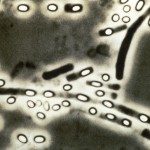Lien vers Pubmed [PMID] – 19665473
Mol. Aspects Med. 2009 Dec;30(6):467-80
Anthrax is rare among humans, few data can be collected from infected individuals and they provide a fragmentary view of the dynamics of infection and human host-pathogen interactions. Therefore, the development of animal models is necessary. Anthrax has the particularity of being a toxi-infection, a combination of infection and toxemia. The ideal animal model would explore these two different facets and mimic human disease as much as possible. In the past decades, the main effort has been focused on modelling of inhalational anthrax and the perception of specific aspects of the infection has evolved in recent years. In this review, we consider criteria which can lead to the most appropriate choice of a given animal species for modelling human anthrax. We will highlight the positive input and limitations of different models and show that they are not mutually exclusive. On the contrary, their contribution to anthrax research can be more rewarding when taken in synergy. We will also present a reappraisal of inhalational anthrax and propose reflections on key points, such as portal of entry, connections between mediastinal lymph nodes, pleura and lymphatic drainage.

